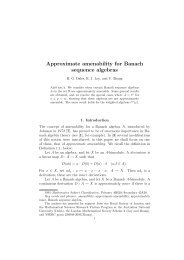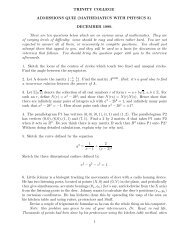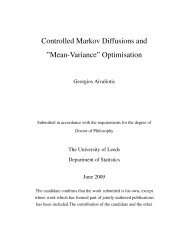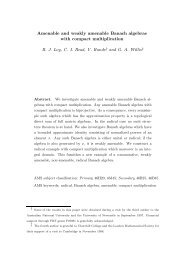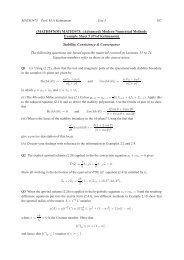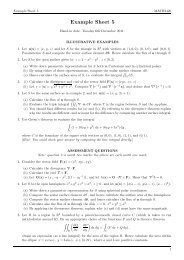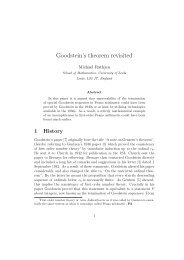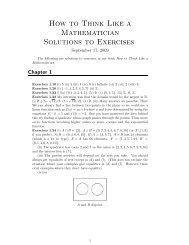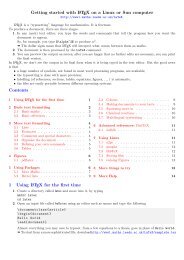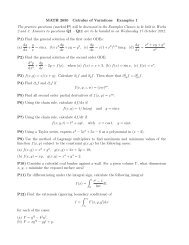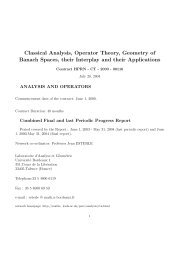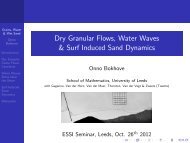A study of time integration schemes for the numerical modelling of ...
A study of time integration schemes for the numerical modelling of ...
A study of time integration schemes for the numerical modelling of ...
You also want an ePaper? Increase the reach of your titles
YUMPU automatically turns print PDFs into web optimized ePapers that Google loves.
A STUDY OF TIME INTEGRATION SCHEMES FOR MODELLING FREE SURFACE FLOWSis used to discretize <strong>the</strong> transport equation (3). A quadratic element is used to discretize <strong>the</strong>pseudo-concentration. The stabilization parameter is given by h=2‖u‖, where h is <strong>the</strong> localmesh size.The continuum surface <strong>for</strong>ce model [12] is used to include <strong>the</strong> inuence <strong>of</strong> surface tensionin <strong>the</strong> <strong>numerical</strong> model. Surface tension is considered as a volume <strong>for</strong>ce dened in <strong>the</strong> smoothregion <strong>of</strong> transition <strong>of</strong> <strong>the</strong> Eulerian marker variable. Formally, <strong>the</strong> surface capillary <strong>for</strong>cef S = n S S is written as a volume <strong>for</strong>ce f V = (F)∇F, dened in <strong>the</strong> region <strong>of</strong> transition<strong>of</strong> F. The Dirac delta function S , dened on <strong>the</strong> interface S, is approximated <strong>numerical</strong>lyin <strong>the</strong> region <strong>of</strong> transition <strong>of</strong> F using ‖∇F‖, and <strong>the</strong> curvature is approximated using( ) ∇F =−∇ · n S ≈−∇ ·‖∇F‖The capillary <strong>for</strong>ce f V is included in <strong>the</strong> Navier–Stokes equations (2) to yield @u@t + (u · ∇)u = ∇ · + f V (5)4. TIME INTEGRATION SCHEMES FOR THE NAVIER–STOKES EQUATIONS4.1. Motivation: Laplace’s problemAn accurate discretization <strong>of</strong> <strong>the</strong> velocity eld <strong>of</strong> <strong>the</strong> uids is important <strong>for</strong> an accurate advection<strong>of</strong> <strong>the</strong> pseudo-concentration (cf. Equation (3)). A well-known free surface ow problem,<strong>for</strong> which an inaccurate discretization <strong>of</strong> <strong>the</strong> transient term <strong>of</strong> <strong>the</strong> Navier–Stokes equations canbe problematic, is Laplace’s problem. The problem consists <strong>of</strong> a ‘two-dimensional’ drop <strong>of</strong>uid <strong>of</strong> an arbitrary shape, an ellipse <strong>for</strong> example, in ano<strong>the</strong>r uid at rest. The capillary <strong>for</strong>cebetween <strong>the</strong> two uids induces a ow which makes <strong>the</strong> drop reach a topology that minimizesenergy, i.e. a circle in two dimensions. The curvature <strong>of</strong> <strong>the</strong> steady-state drop and <strong>the</strong> jumpin pressure should verify Laplace’s law,p 1 − p 2 = (6)This problem is popular <strong>for</strong> verifying <strong>numerical</strong> surface tension models in simulation codes.Despite its simplicity, Laplace’s problem is <strong>numerical</strong>ly challenging. It is well documentedin References [13–18] that if <strong>the</strong> <strong>numerical</strong> strategy is not well chosen, <strong>numerical</strong>lyinduced parasitic currents will appear in <strong>the</strong> vicinity <strong>of</strong> <strong>the</strong> free surface when ‖u‖ →0 (cf.Figure 2(a)). This leads to an inaccurate discretization <strong>of</strong> <strong>the</strong> jump in pressure at <strong>the</strong> freesurface (cf. Figure 2(b)), and eventually to a ow that does not reach a steady-state. Severalhypo<strong>the</strong>ses are brought <strong>for</strong>ward in <strong>the</strong> literature in order to explain this phenomenon and tond a cure.Ko<strong>the</strong> et al. [14] convolve <strong>the</strong> marker variable F with various smooth kernels to obtaina mollied colour function ˜F. This leads to a more accurate computation <strong>of</strong> <strong>the</strong> unit normalto <strong>the</strong> free surface n S and <strong>of</strong> <strong>the</strong> curvature , which in turn reduces parasitic currents. O<strong>the</strong>rauthors have improved <strong>the</strong> <strong>numerical</strong> discretization <strong>the</strong>y were using in order to obtain a moreaccurate <strong>modelling</strong> <strong>of</strong> interfacial physics. This is <strong>the</strong> case <strong>of</strong> Popinet and Zaleski [15] whouse higher accuracy discretizations <strong>of</strong> <strong>the</strong> Lagrangian representation <strong>of</strong> <strong>the</strong> free surface, and<strong>of</strong> <strong>the</strong> pressure, which leads to a reduction <strong>of</strong> parasitic currents. In a similar fashion, <strong>the</strong>Copyright ? 2005 John Wiley & Sons, Ltd.Int. J. Numer. Meth. Fluids (in press)



